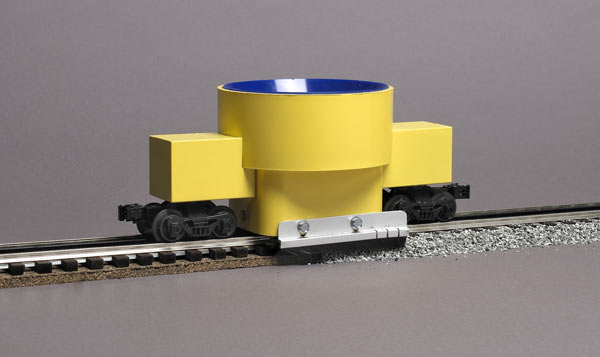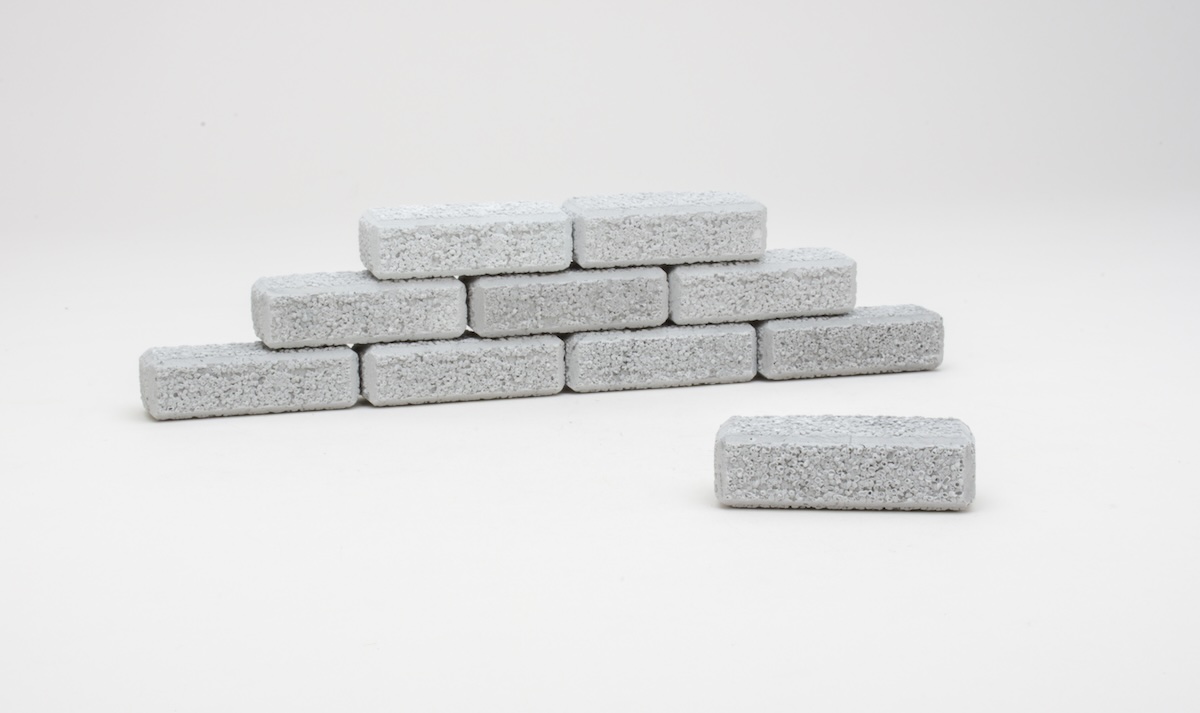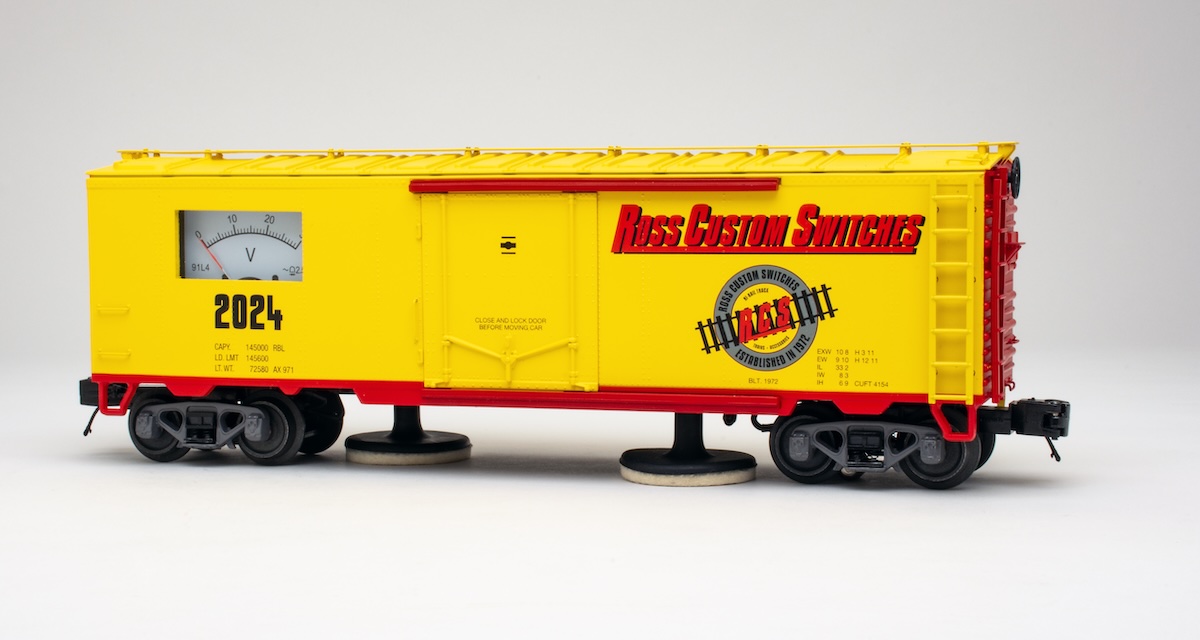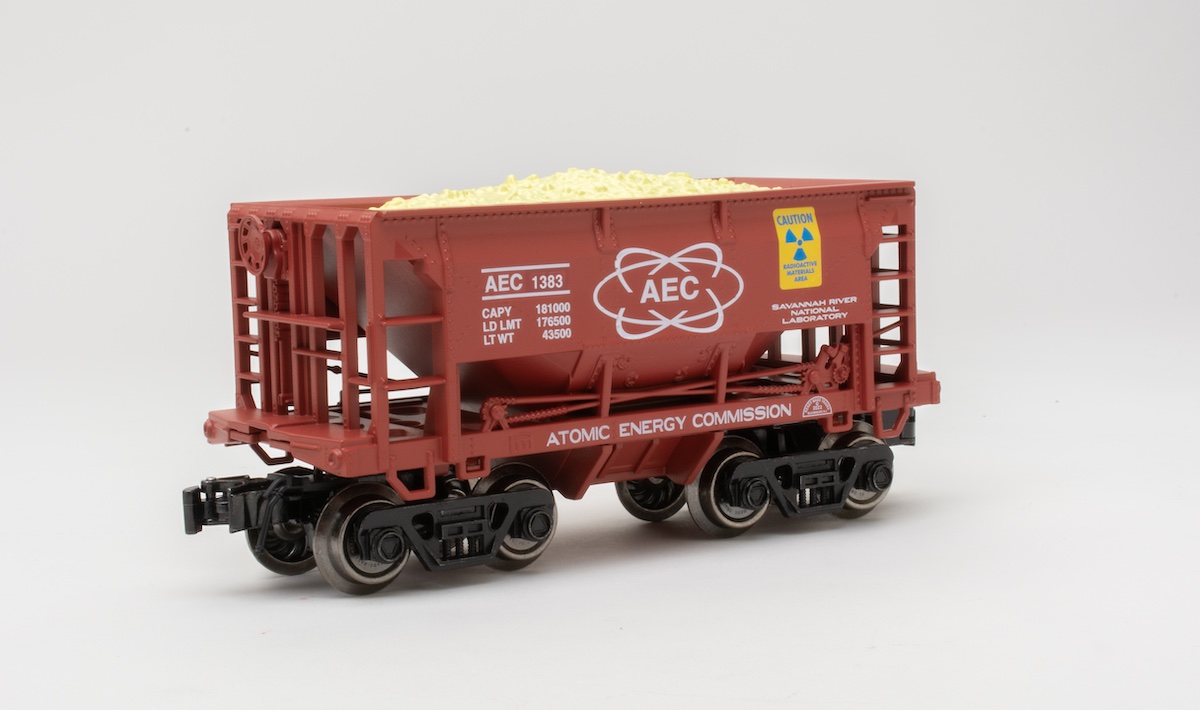Depending on the scope of the project, I may use either a plastic cup – or a cut-open one-gallon water jug filled with ballast.
I pour it down on the track and then use a paintbrush for general shaping and tamping, and maybe an expired AAA card to help form the sides of the ballast. But there are other ways of laying down ballast.
One of the terrific things about the toy train world is that there are many paths to happiness and many ways to accomplish tasks. Some people in the hobby seek a rigid formula for doing things, while others kick back and think it up as they go along.
What often results from the perspective of no preconceived notions are a lot of handy products or methods for doing tasks related to layout building that nobody considered before. A case in point is the Ballast King ballast spreader from O Gauge Connection.
The Ballast King piggybacks on prototype techniques of using hopper-type cars (or dump cars) to lay down ballast.
The end points of the car are steel for weight. Trucks with operating couplers are attached to the end bars.
These bars support what is basically a new kind of hopper or dump car. It is designed for a specific task. The car has a bowl that is 4½ inches wide at the top and tapers toward the bottom for better control of the flow of gravel.
On the sides of the car are two adjustable, angled brushes. These help control the flow of ballast on the sides.
The ballast falls out of the bottom of the car, channeled by a metal plate with gaps for the heads of the rails.
Just behind the bottom plate is a brush for compacting the ballast between the rails.
A prototype of this car has a metal brush for between-the-rails ballast leveling. But after hearing some user suggestions, the manufacturer changed it to a softer bristle brush to avoid any possibility of damaging the finish of the rails. O Gauge Connection gets high marks for listening to its customers and acting swiftly to improve its product.
There are many ballast brands you can use, including ballast offered by Ballast King/O Gauge Connection. I would avoid anything too chunky, like some grades of aquarium rock. Just remember you want it to flow smoothly through the bottom plate.
Okay, so this is an unusual yet clever product. How did it do in action?
On the ballast crew
You could certainly pull or push this car with a locomotive. I avoided doing this simply because some dust is kicked up in the process and you’d need to be fiddling with the transformer (or wireless remote) to accommodate the stopping and going.
I did it old school – by hand – but without sound effects.
I tried three different methods. First was GarGraves track with underlying cork roadbed, second was GarGraves without roadbed, and third was O-31 profile track without roadbed.
Why no roadbed? Not everyone uses cork roadbed, and I certainly never used it for storage tracks (cost avoidance, you know).
After filling the car, I found that it did a terrific job of dropping ballast between the ties of the GarGraves track and down and over the sides of the cork roadbed. Literally, there were no more than a dozen individual pieces of ballast askew. Everything was right where I needed it.
Next up was O-31 tubular without ballast. The height of the metal ties masked the fact that there was no cork roadbed, and I thought it looked great. In my eye, it was even better that the GarGraves with roadbed.
The down side is that you may run through a bit more ballast when doing this. The multiple plastic ties of Atlas O, GarGraves, and MTH ScaleTrax track fill in quite a bit of space. The Lionel tubular track with three metal ties per section leaves a lot of gaps to fill.
Last was GarGraves on a flat surface, sans roadbed. The first thing I noticed was that the side brushes were dragging on the tabletop (this wasn’t the case with the higher O-31 track). You can make an adjustment by loosening the screws and moving the side brushes into a new position, then tighten the screws to lock the brushes into place. This should provide the clearance you need. So unless you make the adjustment, you won’t get as neat and clean a dispersal and you’ll bend your bristles!
The Ballast King ballast car is an interesting solution to the problem of ballasting your O gauge right-of-way – and a way to add a wee bit of fun to the task, too.
Features: Solid construction, brushes to shape and pack the ballast, trucks have operating couplers
Available from Ogaugeconnection.com or order from Russ Boersma, 12817 Briar Dr., Leawood, KS 66209.















It appears to work really well but it's a lot of money to spend for a unit you will basically only use once. What do you do with this car after your ballast is applied?
This it looks to be a whole lot faster than ballasting track byhand
looks like it works well but its a little costly
Has O Gauge Connection thought about providing this for other gauges, namely S?
An expensive way to ballast a layout.
This looks like it leaves a great effect on the rail bed. Have you tried it on
Lionel fast track to take away the manufactured look?